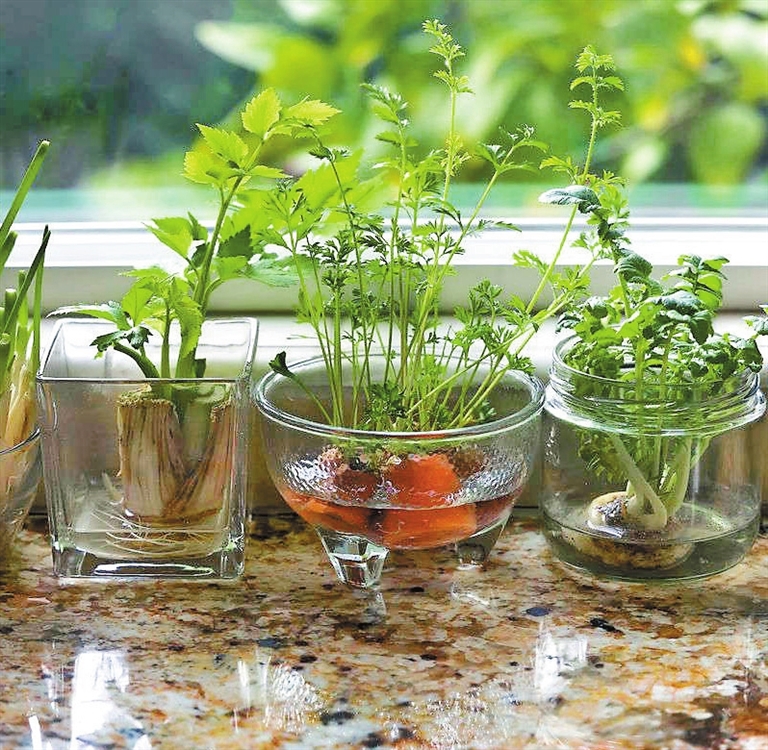

WHILE many of us are taking it slow and work from home during the recent flare-up of the COVID, spring has come quietly to our city. Spring is a great time to grow plants, and instead of buying brand-new plants and vegetables for your balcony, you can grow them for free (or next to nothing) just by recycling kitchen scraps and yard cuttings you already have. Sure, you’ll need to be patient — even the simplest of greens will take a couple weeks to grow — but the payoff is in the pleasure of growing your own plants and veggies. All you need is a windowsill for light, a few paper cups or small glasses to get the cuttings started, and some patience. Basil and other herbs Herbs such as basil, cilantro and mint grow quickly with little nurturing needed. Take a cutting about 6 inches (15 cm) long, remove leaves on the first couple inches of the stem, then place the herb in a glass with an inch or so of water. You should see roots and new leaves forming within a week. Once the cutting takes off, you can keep it in its glass or transplant it to a small pot. To keep the herb healthy, never harvest more than about a third of the new growth. Romaine lettuce Simple greens such as lettuce, spinach and arugula are fast growers that can produce salad-ready leaves in two weeks. Begin with the heart from a head of romaine lettuce (about the size of a tennis ball or slightly bigger). Slice it horizontally on the base, then place in a bowl or glass and fill with about a half-inch of water. Refill as needed. You’ll have enough leaves to garnish a sandwich in 10 to 14 days. When you harvest, be sure to leave a few of the inner leaves to keep growing. Green onions Spring onions are another cinch to regrow. Next time you buy a bunch, cut them so as to leave the white root bulb and about a half-inch to an inch of green above. Place them in a glass with enough water to submerge the white parts, give them sunshine on a windowsill, and you’ll have sprouts in less than two weeks. You can also plant the rooted ends in soil and grow them from a pot. Garlic Leave a clove of garlic out long enough and it’ll begin to sprout. Don’t toss it; plant it! Get the roots going by sticking the clove in a shot glass or other small container, root side down, and keep the bottom submerged. Shoots will appear in about five days, which can be diced and used as you would chives or green onions. Plant the rooted clove in gardening soil, about 1 to 2 inches deep, and keep soil moist. The garlic should be ready to harvest in about three months when the stems have yellowed and collapsed. Onion Take the root end of an onion and simply place it, root side down, into a small pot filled with good-quality potting soil. Cover with an inch or two of soil and keep moist. Roots should begin to form in a week, and shoots should appear soon thereafter. Pull up the onion gently and divide it so each shoot has a portion of the rooted base. Repot each cutting, cover with soil, and water as needed. You’ll have a whole new onion in about 90 to 120 days. Celery, bok choi, and napa cabbage By now, you know the drill. Begin with a root end about 2 or 3 inches thick and place root-side down in a bowl with about an inch of water. Roots should appear within a week to 10 days, and new leaves will begin to sprout from the top. Transfer the rooted base to a plant pot and cover with soil, leaving only the leaves exposed. You’ll have a ready-to-eat plant in about two or three months. Potatoes You’ll need an outdoor garden for this project, and some patience. Planting can begin as soon as your tuber has sprouted eyes that are about a half-inch to inch long. Small potatoes (those less than 2 inches in length) can be planted whole; larger potatoes should be sectioned with a couple eyes in each chunk. Allow pieces to sit out for 24 to 48 hours to scab over, then plant and cover with 3 to 4 inches of soil. If you’re planting more than one, be sure to space them about 1 foot apart in your garden. Sprouts should appear in 12 to 16 days; edible tubers can be harvested in about three months. Rosemary This woody perennial can be used in cooking or as landscaping. Snip a branch that’s about 5 to 6 inches in length and pluck the leaves from the bottom 2 inches. Place in water in a sunny location; be sure to change out the water every few days to keep it clear. You’ll see roots begin to develop within a month or so. After about eight weeks, you can transplant them to a pot filled with well drained soil. Avocado You probably won’t be enjoying home-grown avocados with this project, but you will end up with a nice-looking houseplant. Gently wash an avocado pit (do not remove the outer membrane) and embed three or four toothpicks around the circumference of the upper third at regular intervals. That way you can suspend the pit over a glass filled with water so the lower half is submerged. Keep it filled. You’ll see roots begin to emerge from the base of the pit and a sprout from the top in about four to eight weeks. Once the stalk is about 6 inches tall, it’s ready to pot. If you eventually replant it outdoors and give it at least five years, you might start to see avocados come in. Other easy plants from cuttings The great thing about houseplants is that many of them are a cinch to grow from cuttings in a glass or vase of water. One of the easiest is pothos, a trailing green vine with large, heart-shaped leaves that can thrive in nothing more than water. Spider plants are just as simple to propagate; just snip one of the plantlets from the runner (which, incidentally, is called a stolon) and place the base in water until it roots. Cutting from African violets, coleus, and spiderwort are also happy to take root in water.(SD-Agencies) | 
